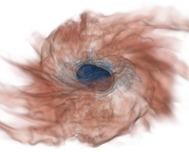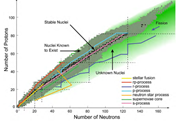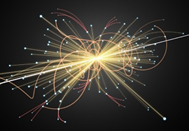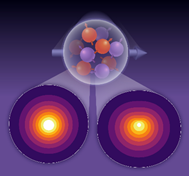Computational Nuclear Physics
NP Scientific Discovery through Advanced Computing (SciDAC) partnership
SciDAC supports research on current high-profile, computationally intensive topics in theoretical nuclear physics of direct relevance to the experimental and theoretical research programs and programs at existing or approved NP facilities.
Current NP SciDAC’s projects: (2022-2026)

Exascale Nuclear Astrophysics for Facility for Rare Isotope Beams (ENAF) is studying the astrophysical events responsible for the production of many of the heaviest of the chemical elements using simulations containing the most complete physics available, including input from nuclear laboratories, like the Facility of Rare Isotope Beams (FRIB). In turn, the understanding of the thermodynamical conditions within these events that is revealed by the simulations helps to guide experiments at these nuclear laboratories.

Nuclear Computational Low Energy Initiative (NUCLEI) focuses on computational low-energy nuclear physics and applied math/computer science that is relevant to DOE experimental facilities FRIB, ATLAS, and JLab and to future 1-ton scale neutrino experiments such as LEGEND. The project is improving information on nuclear interaction and currents together with a more sophisticated quantification of uncertainties to make reliable predictions for stable nuclei and rare isotopes, the electroweak response of nuclei and nuclear matter, and nuclear fission.

Femtoscale Imaging of Nuclei using Exascale Platforms is developing a unique event-level inference framework to obtain a quark and gluon tomography of nucleons and nuclei using high-energy scattering data. This event-level approach will have a transformational impact on the data analysis workflow that connects theory with experimentation.

Fundamental nuclear physics at the exascale and beyond is an ambitious program of theoretical, algorithmic and software development to enable calculations using lattice Quantum Chromodynamics (LQCD) methods to further the understanding of results from heavy ion experiments at the Relativistic Heavy-Ion Collider (RHIC), the excited and exotic states of hadrons at CLAS-12 and GlueX at Jefferson Lab (JLab) and the hadron and nuclear structure programs at RHIC-spin and JLab.

Topical Collaborations
Topical Collaborations were established in 2010 with the goal of bringing together resources from multiple institutions in a coordinated way to address well-defined problems or topical areas that are beyond the efforts of the Theory base program. These collaborations serve, on a temporary basis, as hubs of leading nuclear theorists, leveraging university resources, and providing expanded opportunities for the next generation of nuclear theorists.
Current Topical Collaborations:

Quark-Gluon Tomography collaboration is improving the understanding of the “3D quark-gluon structure of hadrons: mass, spin, and tomography.” The collaboration is built upon three foundational pillars: theory, lattice QCD, and phenomenology. Collaboration website: Quark-Gluon Tomography collaboration - QGT Collaboration


Nuclear Theory for New Physics Collaboration (NTNP) is improving (i) precision calculations of β decays of neutron and nuclei; (ii) calculations of Electric Dipole Moments (EDMs) of neutral diamagnetic atoms; and (iii) precise calculations of neutrino-nucleus scattering processes, a key ingredient entering the measurement of CP-violation in neutrino oscillations at long-baseline experiments. NTNP Collaboration is jointly funded by NP and HEP. Collaboration website: science | NTNP (lbl.gov)

The Exotic Hadron Collaboration (ExoHad) is exploring all aspects of exotic hadron physics, from predictions within lattice QCD, through reliable extraction of their existence and properties from experimental data, to descriptions of their structure within phenomenological models. Collaboration website: ExoHad Collaboration

Heavy-Flavor TheorY (HEFTY) for QCD Matter is developing a comprehensive theory framework to study the spectral and transport properties of heavy quarks and quarkonia in strongly interacting matter, and implement these into quantum transport approaches that will be deployed to the analysis of heavy-flavor observables at the Relativistic Heavy Ion Collider (RHIC) and the Large Hadron Collider (LHC), providing unprecedented and quantitative insights into the microscopic properties of the QGP and its hadronization. Website: HEFTY – Texas A&M University Physics and Astronomy (tamu.edu)

Saturate Glue (SURGE) collaboration is establishing an end-to-end framework for small-x observables by employing Lattice QCD and light-cone method, developing global data analysis tool, and incorporating Monte-Carlo hadronization, to enable “day-one” discovery potential for gluon saturation and spin puzzle. Webpage: https://www.bnl.gov/physics/surge/




